I finished the first book of marks the other day. It's brim full of things - of marks that give me pleasure and that I will want to repeat, and those that are lackluster and repetitive; of those that started out looking great when ink or paint was wet and then dried into dull and dreary; and of those that seemed unspectacular at the time of doing but which seeped and spread and diffused to give really great and unexpected effects.
I've decided that this daily mark-making is a habit I want to continue but I feel I need to approach it in a different way in the next book. This time, my focus is on surfaces and the different effects that can happen when the same media are used on different papers.
I've collected a pile of potentials - the usual drawing papers in various weights, computer paper, old envelopes, tracing paper, parchment paper, newspaper, khadi paper, blotting paper, tracing paper. The pile is growing as I notice the range of papers around me and I wonder ...
The first surface I explored was a heavy blotting paper bought from my local art shop - wonderful textures resulted, here from twisting a nearly-dry 2 inch wide fibre marker over the surface ...
and here from sliding a black Conté crayon on its side down the paper, with varying pressure ...
Then I refilled the 2 inch fiber marker with black fountain pen ink (Quink in the UK) and dragged it horizontally across a choice of papers, varying pressure and reapplying where the spirit moved me. The resulting differences in intensity and colour if ink and texture of mark were most surprising.
First I tried this on
Winsor and Newton medium surface cartridge drawing paper. Here, ink coverage was very even and there was little breaking or changing of the colour. The result was rather flat and gentle.
Then I tried the same process on a rough practice cartridge. Here there were very interesting textural effects and a good intensity of colour where extra layers were applied.
And in the last of these, I repeated the process on khadi paper. Here there were interesting linear textures which reflected the structure of the paper but colour was rather dulled.
I will keep going and I'm drawing useful conclusions from all this. For example, since I'm not as fired up by this as I was by the first book, it's interesting to consider that maybe I'm more instinctively drawn to making the marks themselves than I am to creating the surface on which they appear - or maybe I just haven't found surfaces that I might more enjoy exploring.
I certainly must invest in some more varied types of good drawing / printing paper in order to find out ... any suggestions?
Or maybe it's because I'm short of time as I've also just begun a course with the
Pixeladies to improve my skills with Adobe Photoshop Elements - watch this space ...!
























